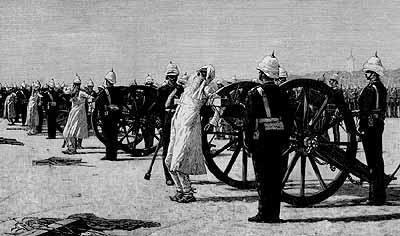 |
 |
Harper's Weekly
November 17, 1888
 "A richer, more inspiring artistic feast has not been offered us in this generation than the Russian painter Vassili Verestchagin has set before us in the Galleries of the American Art Association." "A richer, more inspiring artistic feast has not been offered us in this generation than the Russian painter Vassili Verestchagin has set before us in the Galleries of the American Art Association."So began an article in Harper's Weekly accompanying the above print. Though Vassili Verestchagin (1842-1904) is barely remembered, the effect of his paintings was once considerable. |
| After causing a stir in Europe, an exhibition of his collected works, from landscapes to religious and political themes, became a celebrated event across America in the fall of 1888. One of the central paintings was this scene of Indian soldiers being blown from cannons by the British in Delhi in 1857. |
| Verestchagin's notoriety came from showing some of the most talked about events of the era. This scene was a standard British way to settle scores, and continued long after the war of independence in 1857. It was hotly debated in British and Indian papers between liberals and conservatives. To the former it was an excess of colonialism, to the latter an essential ingredient. As a Russian, Verestshagin was on opposite sides of the British as far as India was concerned. His American audience was also more critical of colonialism. |
| "Mr. Verestchagin's great merit as a painter has been too much lost sight of in the hubbub that has been made over the pictures that deal with sacred and historico-social questions . . ." continues Harper's Weekly.The hubbub was that such a crisp and direct image forced the 19th century viewer to take sides, to either condemn or justify what was happening. |
| Harper's Weekly art critic Clarence Cook thought that Verestchagin was doing the latter. |
|
|